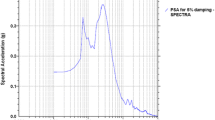Abstract
Past studies have shown that the ground motion is of a highly random nature. It was found in past literature that there exist large variations in ground motion characteristics at other sites for the same earthquake, as well as for the same site from other earthquakes. These large variations in ground motion characteristics illustrate the difficulties in accurately predicting demands of future earthquakes which always leads us to the challenge in identifying the design ground motions that gives a reasonable probability of having credible design provisions. The present study is focused on finding the effect of variations in ground motions on an important design parameter, seismic resilience of a building. The change in ground motion characteristics has been considered through the design acceleration spectrum of the Indian Standard code IS:1893–2016 (Part-1) which depends on several factors viz. Zone factor (Z), importance factor (I) and response reduction factor (R). An existing reinforced concrete building of G + 10 storey with I = 1.5 and R = 5 was considered. The behavior of the building was examined for the six combinations of I/R ratio and corresponding drop down in the functionality and the seismic resilience was evaluated. The result shows the existing building has a significant increase in the demand displacement, demand ductility and loss in seismic resilience at the combination I = 1.5 and R = 3 with increase in the cumulative damage probability of exceedance corresponding to the “Extreme” and “Collapse” state. This was due to the sudden increase in future seismic acceleration (Ah) when compared with designed seismic acceleration.









Similar content being viewed by others
References
Abdollahzadeh, G., & Sadeghi, A. (2018). Earthquake recurrence effect on the response reduction factor of steel moment frame. Asian journal of Civil Engineering, 19, 993–1008.
Ali Hadigheh, S., Saeed Mahini, S., Setunge, S., & Stephen Mahin, A. (2016). A preliminary case study of resilience and performance of rehabilitated buildings subjected to earthquakes. Earthquakes and Structures, 11(6), 967–982.
ASCE/SEI 41-17. (2017). Seismic evaluation and retrofit of existing buildings. American Society of Civil Engineers.
ATC-40. (1996). Seismic evaluation and retrofit of reinforced concrete buildings. Applied Technology Council 1996.
Belejo, A., Andre Barbosa, R., & Bento, R. (2013). Influence of ground motion duration on damage index-based fragility assessment of a plan-asymmetric non-ductile reinforced concrete building. Engineering Structures, 151, 682–703.
Bocchini, P., & Dan Frangopol, M. (2012). Optimal resilience and cost-based post disaster intervention prioritization for bridges along a highway segment. Journal of Bridge Engineering, 17(1), 117–129.
Burton, V. H., Deierlein, G., Lallemant, D., & Lin, T. (2016). Framework for incorporating probabilistic building performance in the assessment of community seismic resilience. Journal of Structural Engineering, 142(8), C4015007. ((1–11)).
Burton, V. H., Deierlein, G., Lallemant, D., & Singh, Y. (2017). Measuring the impact of enhanced building performance on the seismic resilience of a residential community. Earthquake Spectra, 33(4), 1347–1367.
Cai, H., Nina Lam, S. N., Qiang, Yi., Zou, L., Rachel Correll, M., & Mihunov, V. (2018). A synthesis disaster resilience measurement methods and indices. International journal of disaster risk reduction, 31, 844–855.
Cimellaro, G. P., Andrei Reinhorn, M., & Bruneau, M. (2010a). Framework for analytical quantification of disaster resilience. Engineering Structures, 32, 3639–3649.
Cimellaro, G. P., Andrei Reinhorn, M., & Bruneau, M. (2010b). Seismic resilience of a hospital system. Structure and Infrastructure Engineering, 6(1–2), 127–144.
Deco, A., Bocchini, P., & Dan Frangopol, M. (2013). A probabilistic approach for the prediction of seismic resilience of bridges. Earthquake Engineering and Structural Dynamics, 42, 1469–1487.
FEMA-356 Prestandard. (2000). Prestandard and commentary for seismic rehabilitation of buildings, Washington D.C.
FEMA-440. (2005). Improvement of nonlinear static seismic analysis procedures. Federal Emergency Management Agency.
Gehl, P., & D’Ayala, D. (2018). System loss assessment of bridge networks accounting for multi-hazard interactions. Structure and Infrastructure Engineering, 14(10), 1355–1371.
Hakim, R. A., Alama, M. S., & Ashour, S. A. (2014). Seismic assessment of RC building according to ATC-40, FEMA-356 and FEMA-440. Arabian Journal for Science and Engineering, 39, 7691–7699.
HAZUS, MR4 Technical manual. (2003). Multihazard loss estimation methodology. Washington DC, USA: Department of homeland society.
IS:1893. (2016). Part-1. Indian Standard criteria for earthquake resistance design of structures. New Delhi: Bureau of Indian Standards.
Javad Hashemi, M., Ali Al-Attraqchi, Y., Kalfat, R., & Al-Mahaidi, R. (2019). Linking seismic resilience into sustainability assessment of limited-ductility R.C. buildings. Engineering Structures, 188, 121–136.
Mondal, A., Ghosh, S., & Reddy, G. R. (2013). Performance-based evaluation of the response reduction factor for ductile RC frames. Engineering Structures, 56, 1808–1819.
Saeed Mahini, S., Ali Hadigheh, S., & Sujeeva Setunge. (2015). Seismic resilience of retrofitted reinforced concrete buildings. In Proceedings of the second international conference on performance-based and life-cycle structural engineering, Australia.
Venkittaraman, A., & Banerjee, S. (2013). Enhancing resilience of highway bridge through seismic retrofit. Earthquake Engineering and Structural Dynamics, 43, 1173–1191.
Xu, J.-G., Wu, G., & Feng, D.-C. (2019). Near fault ground motion effects on seismic resilience of frame structures damaged in wenchuan earthquake. Structure and Infrastructure Engineering, 16, 1347–1363.
Zou, X. K., Teng, J. G., De Lorenzis, L., & Xia, S. H. (2007). Optimal performance-based design of FRP jackets for seismic retrofit of reinforced concrete frames. Composites Part B: Engineering, 38, 584–597.
Author information
Authors and Affiliations
Corresponding author
Ethics declarations
Conflict of interest
The authors declare that they have no conflict of interest.
Additional information
Publisher's Note
Springer Nature remains neutral with regard to jurisdictional claims in published maps and institutional affiliations.
Rights and permissions
About this article
Cite this article
Prasanth, S., Ghosh, G. Effect of variation in design acceleration spectrum on the seismic resilience of a building. Asian J Civ Eng 22, 331–339 (2021). https://doi.org/10.1007/s42107-020-00316-1
Received:
Accepted:
Published:
Issue Date:
DOI: https://doi.org/10.1007/s42107-020-00316-1




